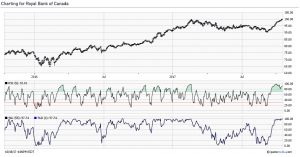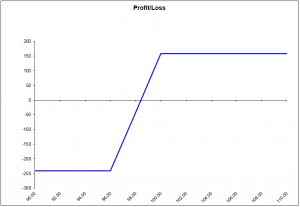Implementation of a collar to protect profits accumulated in Royal Bank of Canada shares

As you can see in the following graph, the price of shares in Royal Bank of Canada (RY), much like the financial sector in general, have shot up over 10% in just six weeks. Even though it is always risky to expect a trend to reverse, such growth cannot continue indefinitely. However, considering that RY just closed at $100.07 on October 18, 2017, in line with a peak reached on February 21 of this year, that the RSI (5) (on 5 trading sessions) is declining in the overbought zone, and, lastly, that the stochastic indicator is in extreme overbought territory, we can expect that the current level is a good place to implement a protective strategy like a collar, which involves financing the purchase of a put option with the sale of a call option.

Position
The collar could be implemented as follows:
| Position on October 18, 2017 | Price per share | Cash inflow /
outflow per contract |
| 100 shares of RY | $100.07 | |
| Sale 1 call option RY 20180119 C 100 |
$1.85 | Credit of $185 |
| Purchase 1 put option RY 20180119 P 96 |
$1.10 | Debit of $110 |
| Sub-total | Credit of $0.75 | |
| Dividend paid on October 25 2017 | 0,91 $ | Crédit de 91 $ |
| Total | Credit of $1.66 |
Profit and loss diagram for the collar on RY

| Per share | Per contract | |
| Breakeven price | $98.41 | |
| Maximum profit | $1.59 | 159$ |
| Maximum loss | $2.41 | 241$ |
As you can see, setting up the collar gives an initial credit of $0.75 per share ($75 per contract), and comes with an opportunity to receive a dividend of $0.91 per share ($91 per contract), for a total credit of $1.66 per share ($166 per contract). The dividend will be redeemed if RY is trading below $100 the day before October 25, 2017. Assuming that the dividend is received, the strategy gives a maximum profit of $159 per contract if the price of RY upon expiration is greater than or equal to the strike price of $100, and it gives a maximum loss of $241 per contract if the price of RY upon expiration is less than or equal to the strike price of $96. The $98.41 breakeven price marks the transition point between making a profit and incurring a loss.
To summarize, we used the sale of call options to finance the purchase of all the put options. These put options offered us protection against the price falling below $96 and gave us an additional credit of $0.75 per share, providing an additional cushion. On the other hand, this sale obliges us to sell the shares at a price of $100, which limits our potential profit if the price rises. In the current situation, this seems an acceptable compromise for anyone interested in protecting their gains for a while.
Good luck with your trading, and have a good week!
The strategies presented in this blog are for information and training purposes only, and should not be interpreted as recommendations to buy or sell any security. As always, you should ensure that you are comfortable with the proposed scenarios and ready to assume all the risks before implementing an option strategy.
President
Monetis Financial Corporation
Martin Noël earned an MBA in Financial Services from UQÀM in 2003. That same year, he was awarded the Fellow of the Institute of Canadian Bankers and a Silver Medal for his remarkable efforts in the Professional Banking Program. Martin began his career in the derivatives field in 1983 as an options market maker for options, on the floor at the Montréal Exchange and for various brokerage firms. He later worked as an options specialist and then went on to become an independent trader. In 1996, Mr. Noël joined the Montréal Exchange as the options market manager, a role that saw him contributing to the development of the Canadian options market. In 2001, he helped found the Montréal Exchange’s Derivatives Institute, where he acted as an educational advisor. Since 2005, Martin has been an instructor at UQÀM, teaching a graduate course on derivatives. Since May 2009, he has dedicated himself full-time to his position as the president of CORPORATION FINANCIÈRE MONÉTIS, a professional trading and financial communications firm. Martin regularly assists with issues related to options at the Montréal Exchange.
The information provided on this website, including financial and economic data, quotes and any analysis or interpretation thereof, is provided solely for information purposes and shall not be construed in any jurisdiction as providing any advice or recommendation with respect to the purchase or sale of any derivative instrument, underlying security or any other financial instrument or as providing legal, accounting, tax, financial or investment advice. Bourse de Montréal Inc. recommends that you consult your own advisors in accordance with your needs before making decision to take into account your particular investment objectives, financial situation and individual needs.
All references on this website to specifications, rules and obligations concerning a product are subject to the rules, policies and procedures of Bourse de Montréal Inc. and its clearinghouse, the Canadian Derivatives Clearing Corporation, which prevail over the content of this website. Although care has been taken in the preparation of the documents published on this website, Bourse de Montréal Inc. and/or its affiliates do not guarantee the accuracy or completeness of the information published on this website and reserve the right to amend or review, at any time and without prior notice, the content of these documents. Neither Bourse de Montréal Inc. nor any of its affiliates, directors, officers, employees or agents shall be liable for any damages, losses or costs incurred as a result of any errors or omissions on this website or of the use of or reliance upon any information appearing on this website.
BAX®, CADC®, CGB®, CGF®, CGZ®, LGB®, MX®, OBX®, OGB®, OIS-MX®, ONX®, SCF®, SXA®, SXB®, SXF®, SXH®, SXM®, SXO®, SXY®, and USX® are registered trademarks of the Bourse. OBW™, OBY™, OBZ™, SXK™, SXJ™, SXU™, SXV™, Montréal Exchange and the Montréal Exchange logo are trademarks of the Bourse. All other trademarks used are the property of their respective owners.
© 2024 Bourse de Montréal Inc. All Rights Reserved.
